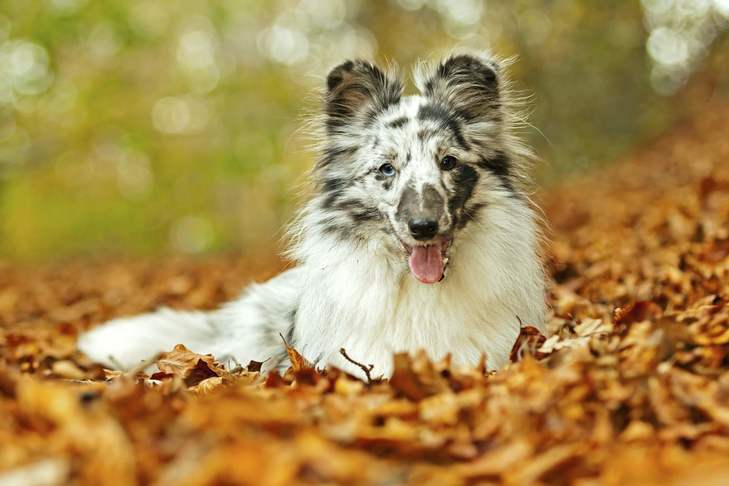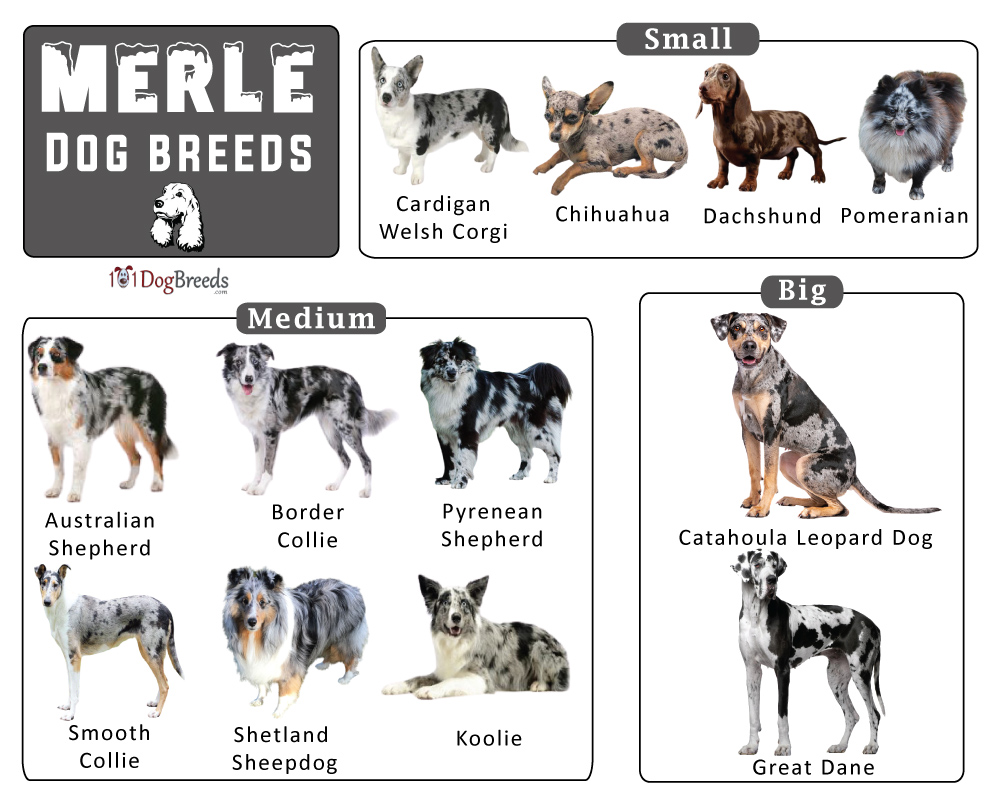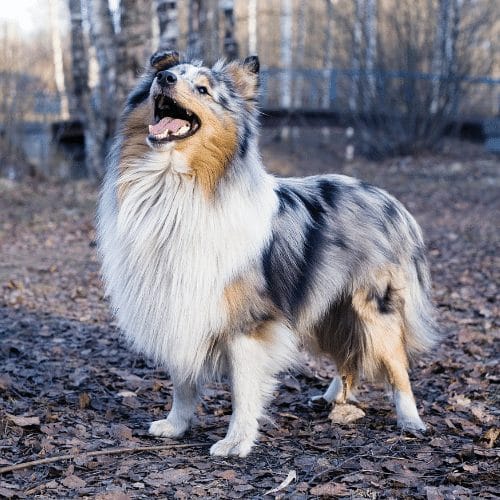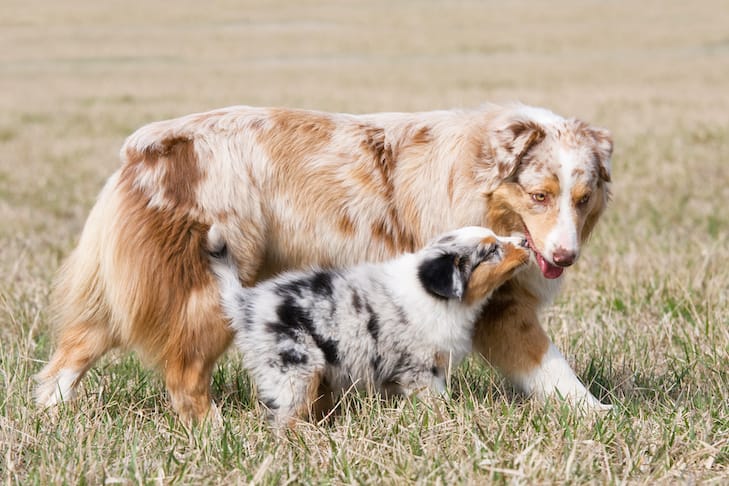
Introduction to the Merle Coat Pattern
Among the most fascinating and strikingly beautiful traits of many dog breeds is their merle coat pattern. Usually black patches or swirls over a lighter base, this remarkable hue is distinguished by a mottled or patchy mix of colors that creates an original and creative look. Based on the breed and genetic variance, the merle pattern can show in blue, chocolate, even red in several tones.
This pattern results from a unique genetic mutation in the PMEL gene influencing dog coat pigment generation. The end effect is a coat that often shows different degrees of color intensity, which makes every dog distinct endlessly. Merle is especially unique in that, unlike human fingerprints, no two merle canines are identical.
The merle pattern is important not just for appearance but also for breed standards and the identification of some breeds. Especially merle is common in breeds including Australian Shepherds, Catahoula Leopard Dogs, and Great Danes. For dog enthusiasts, this color has come to represent certain breeds and help to explain their attractiveness and popularity. However, breeding for merle should be done very carefully. Since breeding two merles could cause major health problems in progeny, many breeders stress the need of health and temperament above color. Therefore, appropriate methods of breeding depend on an understanding of merle genetics.
Understanding Merle Breeds
Characteristics of Merle Dogs
With their beautiful coats with uneven areas of color against a lighter backdrop, merle dogs are really a visual feast. This might be a conventional blue merle (black on gray) or a red merle (brown on tan). The distinctive patterns that each individual dog creates define a merle coat more than just its amazing hues.
Fascinatingly, every merle dog possesses one copy of the merle allele (M), so they are genetically “Mm.” This semi-dominant gene implies that the exquisite marbled pattern we all love is produced even from a single copy of the allele. Still, one should proceed carefully. Having two copies of this allele (MM), a double merle dog may have health problems including visual or hearing loss and usually lacks pigment in important places. Thus, it is always advisable to stress responsible breeding methods such as preventing the breeding of two merles together.
Genetic Basis of Merle Coloring
Merle’s genetic story is one of a spectacular mutation in the PMEL gene, which is fundamental for the synthesis of coat colors. The mutation brings a short interspersed nuclear element (SINE), which produces a dog’s fur with a pattern of subdued coloration.
The length of this SINE can vary, producing various tones and patterns. Mosaicism: Variations in coat patterns on the same dog can arise from certain individual cells carrying distinct forms of the merle gene. This complexity guarantees that no two merles appear precisely alike—each with their own fingerprint of color—a quirky reminder of the beauty found in the variety of nature.
Popular Merle Breeds

Australian Shepherd
Clearly among the most famous dogs displaying the merle coat pattern is the Australian Shepherd. Because of conscientious breeding methods that couple a merle dog with a non-merle, about forty percent of all Australian Shepherds are merle. For dog enthusiasts, this combination regularly produces a pleasing blend of colors in their litters.
Merle Australian Shepherds are strikingly beautiful with deep tan points accentuating either brilliant blue or red colors. Still, Aussies are hardworking dogs with intelligence and agility that go beyond their looks. Remember that these dogs are ideal friends for busy homes since they flourish with lots of physical and mental stimulus.
Catahoula Leopard Dog
Originating from Louisiana, the Catahoula Leopard Dog is another breed honored for their unusual merle coloring. Usually combining the hues of merle to create an eye-catching camouflage effect, these canines have a unique mix of colors ranging from cream to dark black.
Originally raised for hunting wild pigs, Catahoulas are athletic and intelligent with a strong work ethic. Their great vitality makes them ideal for experienced owners who can offer lots of training and exercise.
Great Dane
Renowned for their outstanding height, Great Danes also enjoy the merle coat pattern’s elegance. Though most known for their fawn or harlequin hues, blue merles have captivated hearts with their understated grace.
Usually showing less contrast between the base coat and patches, these large dogs have their merle marks in somewhat varied ways. Great Danes are gentle giants with loving and kind disposition despite their size. To guarantee your friend lives a long, happy life, however, like with any breed—especially larger ones—you must find puppies from conscientious breeders who give health and well-being top priority.
Temperament and Behavior of Merle Breeds
General Temperament
Regarding temperament, merle breeds sometimes have a vivid personality that recalls their background as working dogs. Intelligence, loyalty, and trainability abound in breeds like the Australian Shepherd and Border Collie.
Energetic: Many merle dogs are happiest when they have a purpose and flourish on exercise. To keep balanced, they often seek cerebral stimulation and are naturally curious. If appropriately socialized, these dogs are typically affectionate friends that form tight bonds with their households. They can be lighthearted with young children and like being part of the action.
If improperly trained, several merle breeds may show herding tendencies—that is, nipping. To properly harness their energy, then, they must have a robust and continuous exercise program.
Training and Exercise Requirements
To maintain both physically and psychologically in peak shape, merle breeds usually need a significant degree of exercise. For example, an Australian Shepherd could require two hours of daily exercise, yet because of their working experience, Catahoula Leopard Dogs flourish with similar degrees of activity.
- Aim for at least one daily lengthy walk.
- Engage their intellectual curiosity by having them participate in brain games or training courses.
Your merle dog could show unwelcome habits including chewing or too much barking without enough exercise and excitement. Training and activity must be given time; they help to produce a happy and well-adjusted friend—qualities that make merle breeds especially unique.
Care and Maintenance of Merle Dogs

Grooming Advice
Beyond appreciating their distinctive hair pattern, a merle dog’s general health and attractiveness depend on consistent maintenance. Like the Australian Shepherd and Rough Collie, many merle breeds have thick, luxuriant fur that calls for commitment. These pointers will help your merle pup stay looking sharp:
- Brushing: Try to give your dog minimum one weekly brushing. Daily brushing is best for dogs with longer fur, including Collies, to avoid mats and tangles.
- Usually every six to eight weeks, bath your dog if they start to smell or if they roll in something unpleasant. To preserve coat condition, use a mild dog shampoo.
- Look for matting in places behind the ears, between the legs, beneath the collar; these regions can mat readily.
Not only will you guarantee a well-kept coat but also deepen your relationship with your pet by turning grooming into an enjoyable activity with rewards and compliments.
Health Issues Related to Merle Breeds
Although merle dogs are quite beautiful, their gene raises some possible health issues. Owners need to be informed:
- Double merle dogs—those with two copies of the merle gene—are more likely to have hearing and visual problems including microphthalmia, in which case the eyes do not form correctly.
- Many Vet Visits: Plan frequent veterinarian visits to track your dog’s condition. Early identification of issues can improve results.
Always find merle dogs from conscientious breeders who give health testing top priority. Taking early care for your merle pup can assist to keep it lively, healthy, and happy!
Controversies in Merle Breeding

Health Risks of Merle-to-Merle Breeding
The health issues related to breeding merles to each other are among the most important issues facing the merle breeding society. Pairing two merle dogs (both possessing a merle allele) runs a significant chance of producing “double merle” puppies—dogs with two copies of the merle gene.
Double merles run a great danger for major medical problems including:
- Deafness in particular
- Visual problems including microphthalmia (abnormally small eyes)
- More chance of skin cancer in exposed areas lacking pigment.
Many breeders stress the need of knowing genetics and responsible breeding techniques and oppose mating two merles together considering these hazards.
Ethical Considerations
Merle breeding raises ethical questions outside of only health ones. Many contend that breeding for a desired coat pattern—especially with regard to merle—should not compromise the animal’s health or welfare. Growing numbers of dog enthusiasts believe that temperament, health, and adherence to breed standards should all come first before color.
Responsible breeding requires breeders to undergo health tests and only pair dogs with compatible temperaments. Prospective owners should use great caution in selecting moral breeders who put dog health before appearance. Understanding and acting properly in merle breeding helps guarantee a better future for these lovely pups in a society when looks can surpass inherent value.
Conclusion
The Diversity and Appeal of Merle Breeds
As we draw to a close our study of merle dogs, it is abundantly evident that these breeds display an amazing range of colors and patterns. Merle canines including the Australian Shepherd, Great Dane, and Catahoula Leopard Dog really stand out with their unusual coats that show a remarkable marbling effect. These dogs generally exude an enthusiastic personality and loving disposition that appeal to both dog lovers and families, so their beauty is not only surface level.
From blue to red merles, the variety of merle dogs appeals to many people. Unique Medical Issues: Knowing the complexity of their genetic composition, particularly the possible health consequences, increases our respect of these wonderful friends.
Responsible Ownership and Appreciation
Appreciating the beauty of merle breeds also entails the great responsibility of ownership. The health and welfare of these pets should come first for prospective owners over looks. This indicates:
- Choosing reputable breeders means choosing those who understand the consequences of merle genetics and run health testing.
- Stay current with the particular health issues and care needs particular to merle breeds.
We can make sure that next generations of merle dogs thrive in homes where they are loved and respected for more than simply their beautiful appearance by encouraging responsible ownership and honoring the integrity of these amazing canines.

Leave a Reply